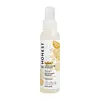What's inside
What's inside
 Key Ingredients
Key Ingredients

 Benefits
Benefits

 Concerns
Concerns

 Ingredients Side-by-side
Ingredients Side-by-side

Water
Skin ConditioningGlycerin
HumectantCetyl Alcohol
EmollientCocos Nucifera Oil
MaskingButyrospermum Parkii Butter
Skin ConditioningCetearyl Alcohol
EmollientGlyceryl Stearate Se
EmulsifyingBehentrimonium Chloride
PreservativeCarthamus Tinctorius Oleosomes
EmollientParfum
MaskingPhenoxyethanol
PreservativeEthylhexylglycerin
Skin ConditioningOlea Europaea Leaf Extract
PerfumingAloe Barbadensis Leaf Juice
Skin ConditioningTocopheryl Acetate
AntioxidantWater
Skin ConditioningGlycerin
HumectantBehentrimonium Chloride
PreservativeCitrus Aurantium Dulcis Peel Extract
Emulsion StabilisingVanilla Planifolia Fruit Extract
Skin ConditioningCitrus Tangerina Peel Extract
AstringentCalendula Officinalis Flower Extract
MaskingChamomilla Recutita Flower Extract
MaskingChenopodium Quinoa Seed Extract
Skin ConditioningCocos Nucifera Oil
MaskingCrambe Abyssinica Seed Oil
Skin ConditioningOrbignya Speciosa Kernel Oil
EmollientArgania Spinosa Kernel Oil
EmollientButyrospermum Parkii Butter
Skin ConditioningAstrocaryum Murumuru Seed Butter
EmollientHydrolyzed Jojoba Protein
Skin ConditioningPanthenol
Skin ConditioningCaprylyl Glycol
EmollientTriethyl Citrate
MaskingCaprylhydroxamic Acid
Citric Acid
BufferingTocopherol
AntioxidantWater, Glycerin, Behentrimonium Chloride, Citrus Aurantium Dulcis Peel Extract, Vanilla Planifolia Fruit Extract, Citrus Tangerina Peel Extract, Calendula Officinalis Flower Extract, Chamomilla Recutita Flower Extract, Chenopodium Quinoa Seed Extract, Cocos Nucifera Oil, Crambe Abyssinica Seed Oil, Orbignya Speciosa Kernel Oil, Argania Spinosa Kernel Oil, Butyrospermum Parkii Butter, Astrocaryum Murumuru Seed Butter, Hydrolyzed Jojoba Protein, Panthenol, Caprylyl Glycol, Triethyl Citrate, Caprylhydroxamic Acid, Citric Acid, Tocopherol
Ingredients Explained
These ingredients are found in both products.
Ingredients higher up in an ingredient list are typically present in a larger amount.
This ingredient is a preservative and often used for it's anti-static properties. You'll most likely see this ingredient in hair conditioners.
It does not cause irritation or sensitization in leave-on products at 1-5%.
This ingredient is also known as shea butter. It is an effective skin hydrator and emollient.
Emollients help soothe and soften your skin. It does this by creating a protective film on your skin. This barrier helps trap moisture and keeps your skin hydrated. Emollients may be effective at treating dry or itchy skin.
Shea butter is rich in antioxidants. Antioxidants help fight free-radicals, or molecules that may harm the body. It is also full of fatty acids including stearic acid and linoleic acid. These acids help replenish the skin and keep skin moisturized.
While Shea Butter has an SPF rating of about 3-4, it is not a sunscreen replacement.
Shea butter may not be fungal acne safe. We recommend speaking with a professional if you have any concerns.
Learn more about Butyrospermum Parkii ButterCocos Nucifera Oil is obtained from the kernels of the coconut fruit. In other words, this is coconut oil.
Coconut Oil is rich in fatty acids with lauric acid making up the majority of these. It also contains linoleic acid. Due to this high fatty acid content, coconut oil helps trap moisture and soften skin.
Despite being antibacterial, coconut oil may not be great for acne-prone skin. It is comedogenic and may clog pores. This ingredient may not be safe for malassezia or fungal acne.
Note: Coconut Oil should not replace your sunscreen for UV protection. Studies show it only blocks about 20% of UV.
This oil is non-volatile and has a light scent.
The term 'fragrance' is not regulated in many countries. In many cases, it is up to the brand to define this term. For instance, many brands choose to label themselves as "fragrance-free" because they are not using synthetic fragrances. However, their products may still contain ingredients such as essential oils that are considered a fragrance.
Learn more about Cocos Nucifera OilGlycerin is already naturally found in your skin. It helps moisturize and protect your skin.
A study from 2016 found glycerin to be more effective as a humectant than AHAs and hyaluronic acid.
As a humectant, it helps the skin stay hydrated by pulling moisture to your skin. The low molecular weight of glycerin allows it to pull moisture into the deeper layers of your skin.
Hydrated skin improves your skin barrier; Your skin barrier helps protect against irritants and bacteria.
Glycerin has also been found to have antimicrobial and antiviral properties. Due to these properties, glycerin is often used in wound and burn treatments.
In cosmetics, glycerin is usually derived from plants such as soybean or palm. However, it can also be sourced from animals, such as tallow or animal fat.
This ingredient is organic, colorless, odorless, and non-toxic.
Glycerin is the name for this ingredient in American English. British English uses Glycerol/Glycerine.
Learn more about GlycerinWater. It's the most common cosmetic ingredient of all. You'll usually see it at the top of ingredient lists, meaning that it makes up the largest part of the product.
So why is it so popular? Water most often acts as a solvent - this means that it helps dissolve other ingredients into the formulation.
You'll also recognize water as that liquid we all need to stay alive. If you see this, drink a glass of water. Stay hydrated!
Learn more about Water